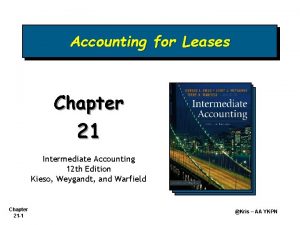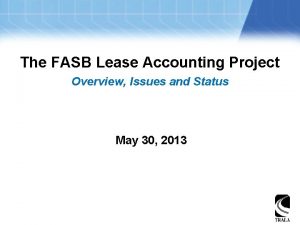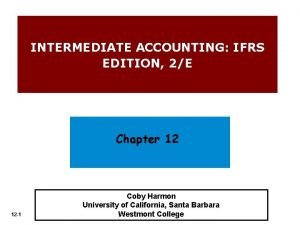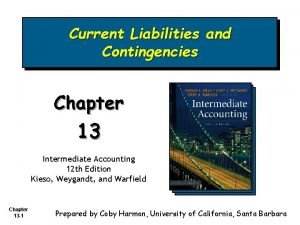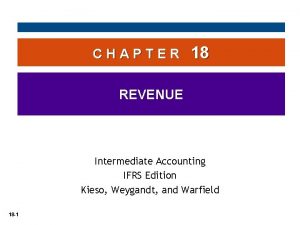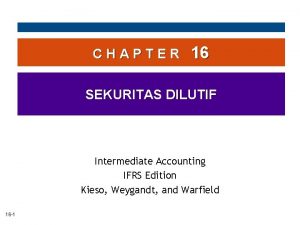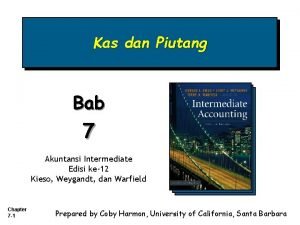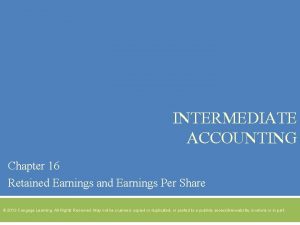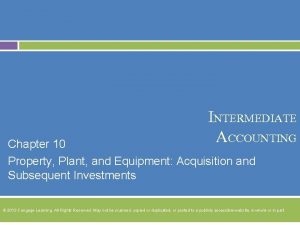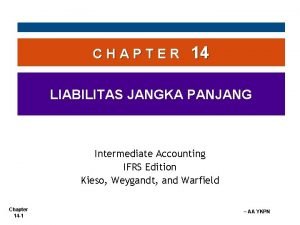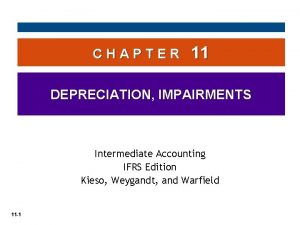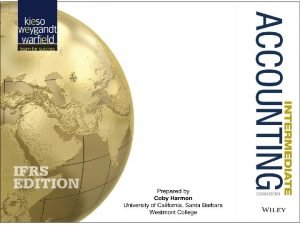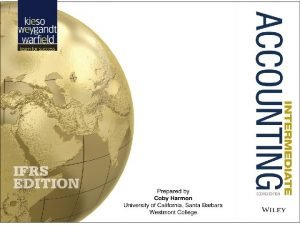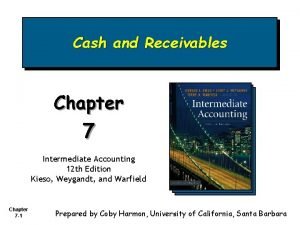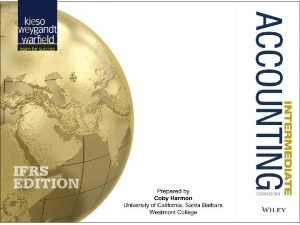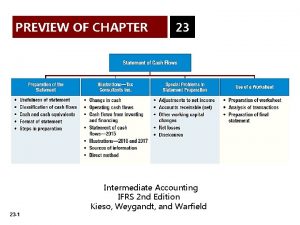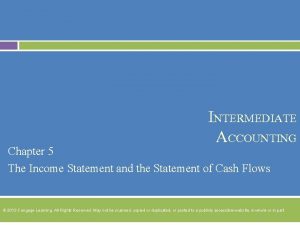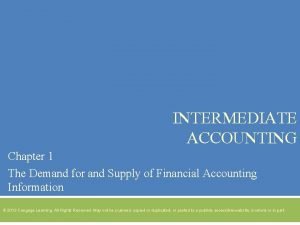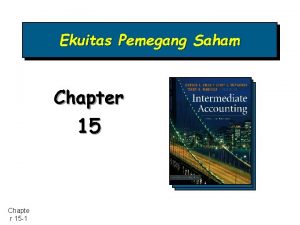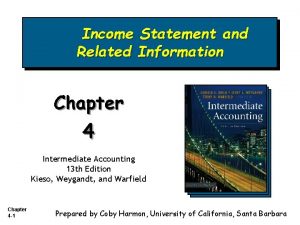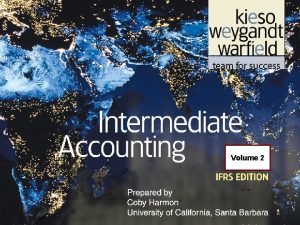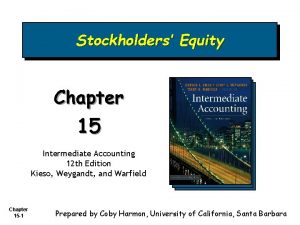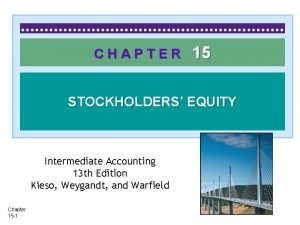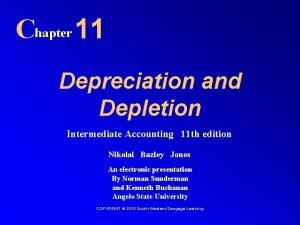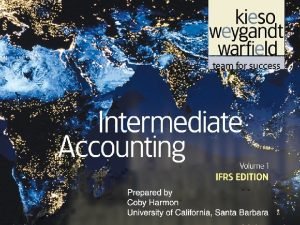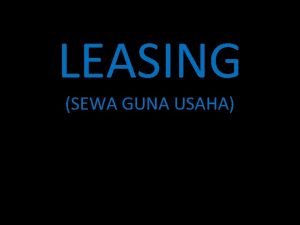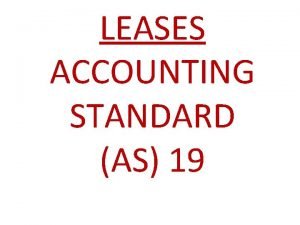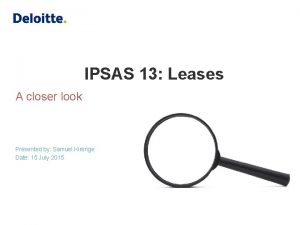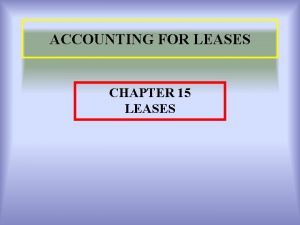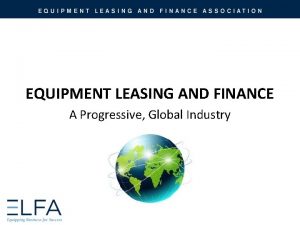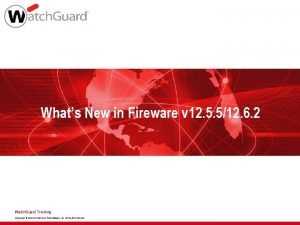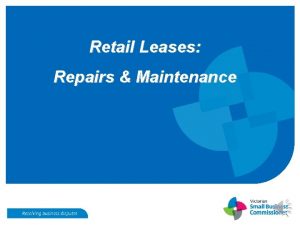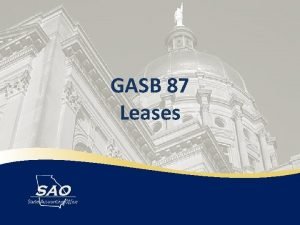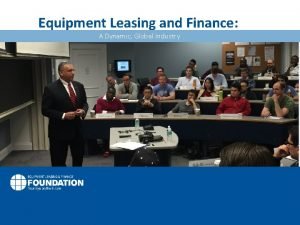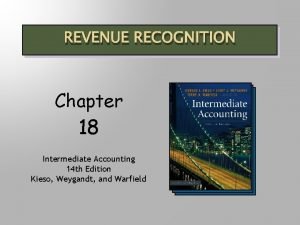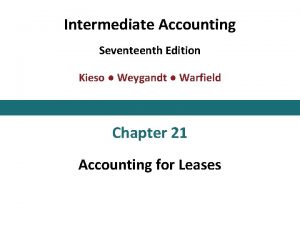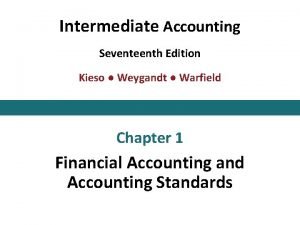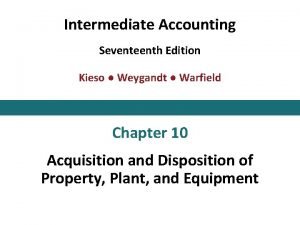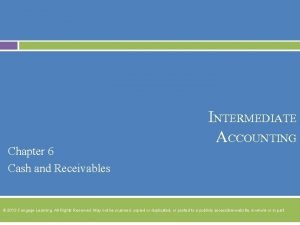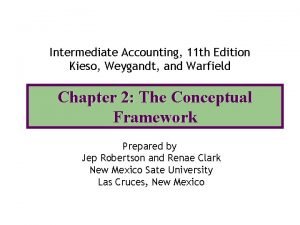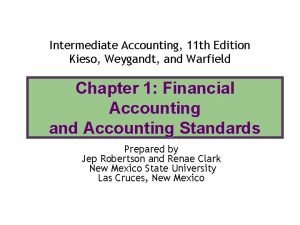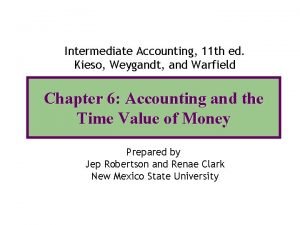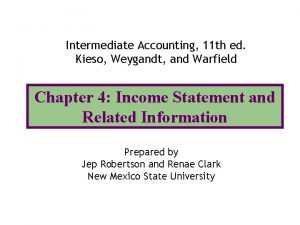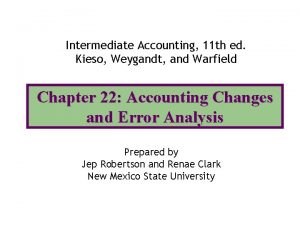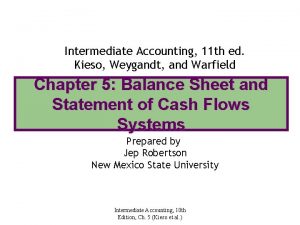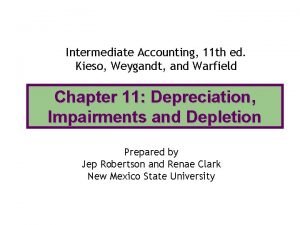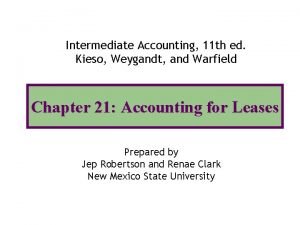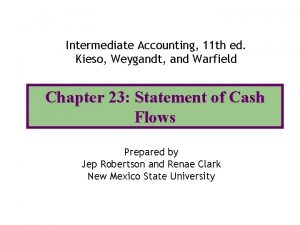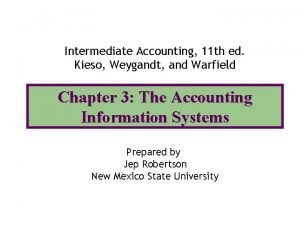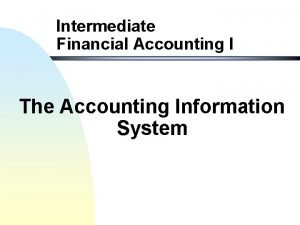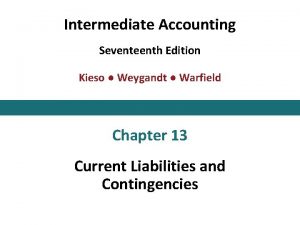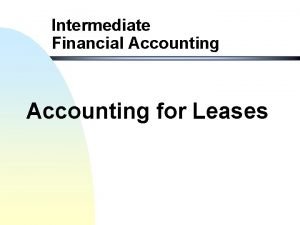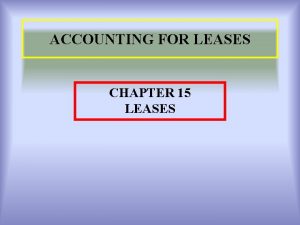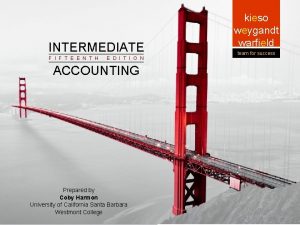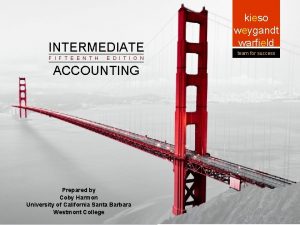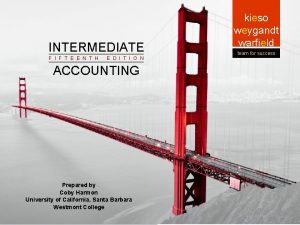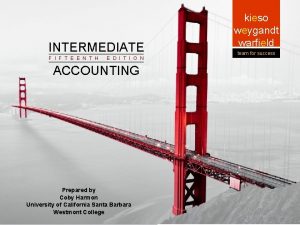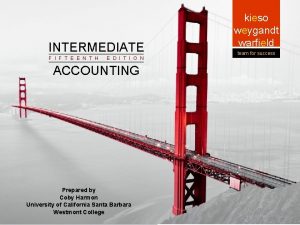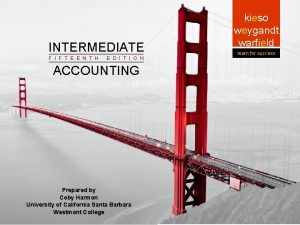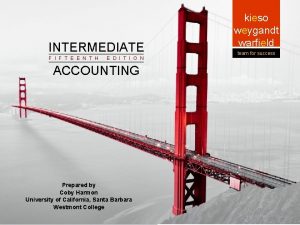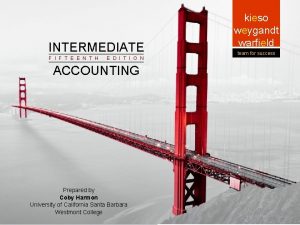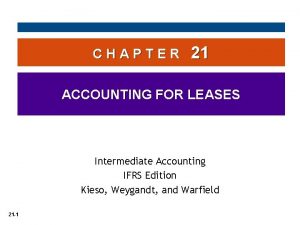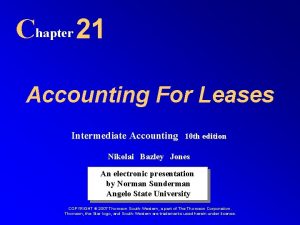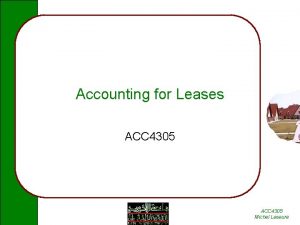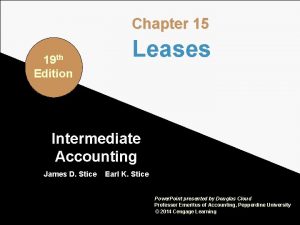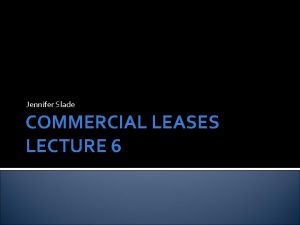Chapter 21 Accounting For Leases Intermediate Accounting 11

































































- Slides: 65

Chapter 21 Accounting For Leases Intermediate Accounting 11 th edition Nikolai Bazley Jones An electronic presentation By Norman Sunderman and Kenneth Buchanan Angelo State University COPYRIGHT © 2010 South-Western/Cengage Learning

2 Leases Leasing is an increasingly popular way to acquire the use of assets. Businesses lease many different assets including office equipment, medical equipment, and manufacturing machinery.

3 Why Do Companies Lease? Companies choose operating leases because the leased asset and the related obligation do not appear on the balance sheet, allowing them to show a more favorable debt ratio and return on assets.

4 Why Do Companies Lease? In general, companies with operating leases report less interest, higher income, and more favorable returns on equity than companies with capital leases.

5 Definition of Lease GAAP defines a lease as “an agreement conveying the right to use property, plant, or equipment usually for a stated period of time. ” A lease involves a lessee and a lessor. A lessee acquires the right to use the property, plant, and equipment; a lessor gives up the right.

6 Leases The primary disadvantage of leasing is that it is usually more expensive in the long run to lease than to buy. However, for many companies the advantages of leasing outweigh the disadvantages.

7 Advantages of Leasing from Lessee’s Viewpoint v v v Financial benefits Risk benefit Tax benefit Financial reporting benefit Billing benefit Continued

8 Advantages of Leasing from Lessee’s Viewpoint Financial Benefits v The lease provides 100% financing, so that the lessee acquires the asset without having to make a down payment. v The lease contract contains fewer restrictive provisions and is more flexible than other debt agreements. v The leasing arrangement creates a claim that is against only the leased equipment and not against all assets.

9 Advantages of Leasing from Lessor’s Viewpoint v A way of indirectly making a sale. v An alternative means of obtaining a profit opportunity in a transaction that enables the lessor company to transfer an asset by the lease agreement. This transfer also permits the lessor to earn a rate of return in the form of interest on the selling price of the leased asset.

10 Key Terms Related to Leasing v Bargain purchase option GAAP defines a number terms used in leasing v Bargain renewal option arrangements. v Estimated economic life of leased property v Estimated residual value of leased property There’s more. v Executory costs v Fair value of leased property v Guaranteed residual value

11 Key Terms Related to Leasing v v v v v Inception of the lease Initial direct costs Interest rate implicit in the lease Lease receivable Lease term Lessee’s incremental borrowing rate Manufacturer’s or dealer’s profit or loss Minimum lease payments Unguaranteed residual value Unreimbursable cost

12 Classification of Leases Involving Personal Property Column A Criteria Applicable to Both Lessee and Lessor A. The lease transfers ownership of the property to the lessee by the end of the lease term. B. The lease contains a bargain purchase option. C. The lease term is equal to 75% or more of the estimated economic life of the leased property. D. The present value of the minimum lease payments is equal to 90% or more of the fair value of the leased property to the lessor.

13 Classification of Leases Involving Personal Property Column B Criteria Applicable to Lessor Only A. The collectibility of the minimum lease payments is reasonably assured. B. No important uncertainties surround the amount of unreimbursable costs yet to be incurred by the lessor under the lease.

14 Classification of Leases Involving Personal Property A capital lease meets one or more of the criteria in Column A. An operating lease does not meet any of the criteria in Column A. Classification by the Lessee

15 Classification of Leases Involving Personal Property A sales-type lease meets one or more of the criteria listed in Column A and both of the criteria listed in Column B. It must result in a manufacturer’s or dealer’s profit (or loss) to the lessor. Classification by the Lessor Sale-type lease

16 Classification of Leases Involving Personal Property A direct financing lease meets one or more of the criteria listed It must not result in a in Column A and both of the manufacturer’s or dealer’s criteria listed in Column B. profit (or loss) to the lessor. Classification by the Lessor Direct financing lease

17 Classification of Leases Involving Personal Property An operating lease meets none of the criteria in Column A or does not meet both of the criteria in Column B. Classification by the Lessor Operating lease

18 Lease Criteria and Classifications

19 Operating Lease (Lessee) The User Company signed a lease agreement with the Owner Company whereby the User Company agrees to pay $50, 000 each year beginning January 1, 2010 and continuing through 2014.

20 Operating Lease (Lessee)

21 Operating Lease (Lessee) Determine how many of the criteria from Column A are met.

22 Operating Lease (Lessee) Since none are met, this is an operating lease.

23 Executory Costs Ownership-type costs such as insurance, maintenance, and property taxes are called executory costs. Executory costs may be paid by either the lessee or the lessor, depending on how the lease contract is written.

24 Discount Rate The lessee computes the present value of the minimum lease payments by using the lower of one of the following: 1. The lessee’s incremental borrowing rate 2. The lessor’s interest rate implicit in the lease, if known by the lessee (or if it is practicable for the lessee to learn)

25 Amortization (Depreciation) of Leased Asset 1. With a capital lease, the lessee records depreciation using the firm’s normal depreciation method. 2. Depreciation occurs over the economic life if the title is transferred or the lease contains a bargain purchase option. 3. Depreciation occurs over the term of the lease if the lease term is equal to 75% or more of the economic life, or the present value of the minimum lease payments is at least 90% of the fair value. 4. Any residual (salvage) is ignored if the residual is not guaranteed.

26 Capital Lease (Lessee) The Martin Company (the lessee) and the Gardner Leasing Company (the lessor) sign a lease agreement dated January 1, 2010, that provides for the Martin Company to lease a piece of equipment from the Gardner Leasing Company beginning January 1, 2010.

27 Capital Lease (Lessee)

28 Capital Lease (Lessee) Is this a capital lease?

29 Capital Lease (Lessee) The lease meets two of the criteria: (a) The lease term is 75% or more of the asset’s economic life and (b) the present value of the minimum lease payments is 90% or more of the asset’s fair value.

30 Bargain Purchase Option Redd Company leases equipment for four years and agrees to pay $2, 000 at the end of the fourth year to purchase the asset. This amount is so much lower than the expected fair value at the end of the fourth year that Redd is reasonably assured that it will exercise the option. Does this qualify as a capital lease? Yes…because of the bargain purchase option.

31 Guaranteed Residual Value Karpas Company leases equipment for four years that cost the lessor $147, 284. 99 (its fair value) and agrees to pay an annual rent of $40, 000 at the end of each year. Karpas Company agrees to guarantee the estimated residual value of $30, 000 at the end of the fourth year. Assume a 10% interest rate.

32 Guaranteed Residual Value Leased Equipment Accumulated Depreciation: Leased Equipment 147, 284. 99 At the end of the lease, both parties agree that the equipment is worth only $20, 000, but the guaranteed residual value was $30, 000. 117, 284. 99 Capital Lease Obligation Accumulated Depreciation: Leased Equipment Capital Lease Obligation Loss on Disposal of Leased Equipment 147, 284. 99 Cash 30, 000. 00 117, 284. 99 30, 000. 00 10, 000. 00

33 Guaranteed Residual Value If the fair value is more than $30, 000, the lessee may pay the liability in full by returning the asset to the lessor.

34 Disclosure Requirements of the Lessee

35 Lessor’s Classifications v Operating Lease v Sales-Type Lease v Direct Financing Lease v Leveraged Lease A leveraged lease is a special three-party lease that is always considered to be a direct financing lease.

36 Operating Lease (Lessor) The Owner Company leases a piece of equipment to User Company for five years. Company agrees to pay $50, 000 at the beginning of each year. The Owner Company purchased the equipment for $300, 000. The equipment has an estimated life of 10 years and Owner Company uses the straight-line method of depreciation. On January 10, 2010 Owner pays the annual insurance premium of $2, 000, and on December 15, 2010 it pays for repairs of $1, 500.

37 Operating Lease (Lessor)

38 Operating Lease (Lessor) Determine how many of the criteria from Column A are met.

39 Operating Lease (Lessor) Since none are met, this is an operating lease.

40 Initial Direct Costs - Operating Lease Initial direct costs are costs that a lessor incurs directly from originating a lease that it would not have incurred if it had not entered into the lease contract. The lessor records these costs as an asset and allocates them as an operating expense in proportion to the rental receipts over the term of the operating lease.

41 Direct Financing Lease (Lessor) Under a direct financing lease, the lessor “sells” the asset at no gain or loss. The net amount at which the lessor records the receivable must be equal to the cost or carrying value of the property. The gross receivable of the lessor includes the sum of: 1. The undiscounted minimum lease payments to be received by the lessor (net of executory costs paid by the lessor), plus 2. Any unguaranteed residual value accruing to the benefit of the lessor.

42 Direct Financing Lease (Lessor)

43 Direct Financing Lease (Lessor) Why is this a direct financing lease?

44 Direct Financing Lease (Lessor) It is a direct financing lease since: (1) one or more of the items listed in Column A are met, (2) both of the criteria listed in Column B are met, and (3) there is no manufacturer’s or dealer’s profit or loss.

45 Sales-Type Lease (Lessor) Take a moment to examine the data in the next slide. Why is this a sales-type lease?

46 Sales-Type Lease (Lessor) Cost of Asset Leased Sales Revenue Lease Receivable ($30, 000 × 10) + $500

47 Sales-Type Lease (Lessor) It is a sales-type lease since (1) one or more of the Column A criteria are met, (2) both of the Column B criteria are met, and (3) there is a manufacturer’s or dealer’s profit or loss.

48 Initial Direct Costs – Sales Type Lease Initial direct costs on a sales type lease are expensed in the period of the sale. v. The lessor could include them in cost of asset leased, or v. It may treat them as a selling expense.

49 Disclosure Requirements for the Lessor

50 Summary of Accounting By Lessee

51 Summary of Accounting By Lessor

52 Summary of Accounting By Lessor

53 Statement of Cash Flows Disclosures – Lessee Operating Lease v Cash outflow in operating section of statement of cash flows Capital Lease v Noncash investing and financing section v Interest portion of each payment is a cash outflow in operating section v Principal portion is a reduction in the obligation and is reported in the financing section

54 Statement of Cash Flows Disclosures – Lessor Operating Lease v Cash inflow in the operating section v Cash paid to purchase the asset is a cash outflow in the investing section Capital Lease v Interest portion of each payment is a cash inflow in operating section v Principal portion is a cash inflow in the investing section

55 Conceptual Issues Why would a lessee or lessor want to avoid capitalizing a lease? The motivation usually comes from the lessee who wants to avoid reporting the liability on its balance sheet.

56 IFRS vs. U. S. GAAP v IFRS for leases are generally similar to U. S. GAAP. However, IFRS focus more on the substance of the agreement rather than the form as defined by the four criteria in the U. S. GAAP. v IFRS are generally less detailed and are considered more principles-based, while U. S. GAAP has more extensive form-driven requirements and is generally considered rules-based. v Terminology differences exist. IFRS classify a lease as either a finance lease or an operating lease.

57 IFRS vs. U. S. GAAP v A finance lease requires capitalization when substantially all of the risks and rewards are transferred, as demonstrated by indicators. v The first two indicators are similar to U. S. GAAP. v The third indicator is less precise because it states that “the lease is for the major part of the economic life of the asset” as compared to the threshold in the United States. v The fourth indicator also differs from the U. S. criterion in that it states that “the present value of the lease payments amounts to at least substantially all the fair value of the asset, ” as compared to the 90% threshold used in the United States.

58 Appendix: Real Estate Lease Issues

59 Appendix: Real Estate Lease Issues

60 Appendix: Real Estate Lease Issues

61 Appendix: Sale-Leaseback Issues v A “sale-leaseback” transaction is one in which the owner of an asset sells it and then immediately leases it back from the buyer. v This kind of transaction may be advantageous to both the lessee and lessor: The lessee receives cash from the sale and may derive a tax advantage, while the lessor acquires an asset. v If the lease meets one of the criteria for treatment as a capital lease, the seller-lessee accounts for the lease as a capital lease. Otherwise, it accounts for the lease as an operating lease.

62 Appendix: Sale-Leaseback Issues v If the lease is a capital issue, the lessee amortizes the profit in proportion to the depreciation of the leased asset. v If the lease is an operating lease, the lessee amortizes the profit in proportion to the payments over the period of time it expects the asset to be used.

63 Impact of Renewal of Lease on Guarantee of Residual Value Suppose, for example, a lessee records a lease as a capital lease while the lessor records it as a direct financing lease, and the lease contains a guarantee of the residual value of the leased property. If at the end of the lease term the lessee elects to renew the lease, this election would not cancel the guarantee of residual value. The renewal, however, is not treated as a new agreement, because there is no change in the lease classification.

64 Changes to Sales-Type or Direct Financing Lease Prior to Lease Term Expiration That Change the Lease to an Operating Lease If changes are made in either sales-type or direct financing lease provisions before the expiration of the lease, and if these changes would have caused the original agreement to be classified as an operating lease, the lessor removes the remaining net investment from its accounts. It replaces the Lease Receivable with an asset at its original cost, fair value, or carrying amount, whichever is lowest, and reports any net adjustment as an operating loss in the period of change. It then accounts for the new lease as any other operating lease.

65 Chapter 21 Task Force Image Gallery clip art included in this electronic presentation is used with the permission of NVTech Inc.
 Lessor versus lessee
Lessor versus lessee Chapter 21 intermediate accounting
Chapter 21 intermediate accounting Chapter 21 accounting for leases kieso terjemahan
Chapter 21 accounting for leases kieso terjemahan I&a accounting
I&a accounting Intermediate accounting chapter 15
Intermediate accounting chapter 15 Intermediate accounting kieso chapter 17 investment
Intermediate accounting kieso chapter 17 investment Patent impairment
Patent impairment Chapter 13 current liabilities and contingencies
Chapter 13 current liabilities and contingencies Intermediate accounting chapter 18
Intermediate accounting chapter 18 Chapter 16 kieso
Chapter 16 kieso Chapter 19 intermediate accounting
Chapter 19 intermediate accounting Bab 7 kas dan piutang kieso
Bab 7 kas dan piutang kieso A restriction/appropriation of retained earnings
A restriction/appropriation of retained earnings Intermediate accounting chapter 10
Intermediate accounting chapter 10 Chapter 2 conceptual framework for financial reporting
Chapter 2 conceptual framework for financial reporting Intermediate accounting chapter 14
Intermediate accounting chapter 14 Chapter 11 intermediate accounting
Chapter 11 intermediate accounting Chapter 3 intermediate accounting
Chapter 3 intermediate accounting Intermediate accounting chapter 15
Intermediate accounting chapter 15 Financial accounting and accounting standards chapter 1
Financial accounting and accounting standards chapter 1 Chapter 13 intermediate accounting
Chapter 13 intermediate accounting Intermediate accounting chapter 2
Intermediate accounting chapter 2 Note receivable journal entry
Note receivable journal entry Lcnrv adalah
Lcnrv adalah Intermediate accounting chapter 23
Intermediate accounting chapter 23 Income statement intermediate accounting
Income statement intermediate accounting Intermediate accounting chapter 1
Intermediate accounting chapter 1 Equity adalah
Equity adalah Chapter 4 income statement and related information
Chapter 4 income statement and related information Intermediate accounting chapter 1
Intermediate accounting chapter 1 Under ifrs the presumption is that equity investments are
Under ifrs the presumption is that equity investments are Property dividend
Property dividend Property dividend
Property dividend Composite depreciation
Composite depreciation Impairment of intangible assets
Impairment of intangible assets Leases adalah
Leases adalah As 19 lease accounting
As 19 lease accounting Ipsas 13 leases
Ipsas 13 leases Types of leases
Types of leases Operating lease
Operating lease Ias 17 leases
Ias 17 leases View dhcp leases watchguard system manager
View dhcp leases watchguard system manager Ifrsbox leases
Ifrsbox leases Section 52 retail leases act
Section 52 retail leases act Gasb 62 leases
Gasb 62 leases Equipment leasing and finance industry snapshot
Equipment leasing and finance industry snapshot Ias 17 leases ppt
Ias 17 leases ppt What is intermediate accounting all about
What is intermediate accounting all about Chapter 18 revenue recognition kieso
Chapter 18 revenue recognition kieso Intermediate accounting
Intermediate accounting Intermediate accounting
Intermediate accounting Commercial substance
Commercial substance Cash and receivables intermediate accounting
Cash and receivables intermediate accounting Primary qualities of accounting information
Primary qualities of accounting information Intermediate accounting
Intermediate accounting Intermediate accounting kieso
Intermediate accounting kieso Intermediate accounting kieso
Intermediate accounting kieso Intermediate accounting kieso
Intermediate accounting kieso Intermediate accounting
Intermediate accounting Intermediate accounting kieso
Intermediate accounting kieso Capital lease 4 criteria
Capital lease 4 criteria Intermediate accounting kieso
Intermediate accounting kieso Intermediate accounting kieso
Intermediate accounting kieso Accounts payable subsidiary ledger
Accounts payable subsidiary ledger Advantages of financial accounting
Advantages of financial accounting Warranty journal entry
Warranty journal entry


